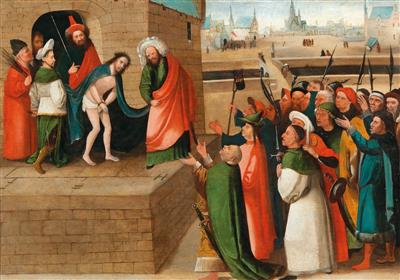Circle of Hieronymus Bosch

(s’Hertogenbosch circa 1450–1516)
Ecce Homo,
oil on panel, 52 x 74 cm, framed
The present painting is an early enlarged variant after Bosch’s painting in the Städel Museum, Frankfurt/Main (circa 1500). Another copy is in the Rijksmuseum, Amsterdam. A recent dendrochronological analysis showed that the panel came from a tree felled in the first half of the sixteenth century.
This composition is of particular interest since the original in Frankfurt is an upright whereas the present panel is of a horizontal format. This difference has lead this anonymous artist to make numerous adjustments and changes to Bosch’s original composition.
If the works by Hieronymus Bosch were already held in high esteem during his lifetime, his fame was to outlast his death in 1516. In the first half of the sixteenth century, innumerable pictures were executed, especially in Antwerp, that were painted in Bosch’s manner or inspired by his art. In this context, Max Friedländer spoke about a ‘fashion’, which Larry Silver identified as a ‘veritable industry of Boschiana’. Peter van den Brink explained this ‘revival of Hieronymus Bosch’ by the fact that Bosch’s pictures were both readily recognisable and relatively easy to imitate. Paintings made by these followers of Bosch sometimes even bore false signatures, as these artists, putting aside their own personalities, sought to profit from Bosch’s popularity. Therefore, it is difficult for doubtful works, dating from Bosch’s own lifetime, to attribute them to Bosch and his workshop. Felipe de Guevara pointed out as early as 1560 that countless pictures in the manner of Bosch could be found, ‘falsely signed with the name of Hieronymus Bosch’.
Amongst the few artists who successfully emerged from anonymity although they closely followed Bosch’s imagery were the Antwerp-based painters Jan Mandyn, Pieter Huys, and Jan Wellens de Cock, as well as Frans Verbeeck, who was active in Malines. However, there can be no doubt that the most famous and most excellent ‘emulator of Bosch’ was Pieter Bruegel the Elder, whom Lodovico Guicciardini praised as ‘grande imitatore della scienza et fantasie di Girolamo Bosco’ and as ‘secondo Girolamo Bosco’ as early as 1567.
Expert: Damian Brenninkmeyer
 Damian Brenninkmeyer
Damian Brenninkmeyer
+43 1 515 60 403
old.masters@dorotheum.com
23.10.2018 - 18:00
- Dosažená cena: **
-
EUR 95.584,-
- Odhadní cena:
-
EUR 80.000,- do EUR 120.000,-
Circle of Hieronymus Bosch
(s’Hertogenbosch circa 1450–1516)
Ecce Homo,
oil on panel, 52 x 74 cm, framed
The present painting is an early enlarged variant after Bosch’s painting in the Städel Museum, Frankfurt/Main (circa 1500). Another copy is in the Rijksmuseum, Amsterdam. A recent dendrochronological analysis showed that the panel came from a tree felled in the first half of the sixteenth century.
This composition is of particular interest since the original in Frankfurt is an upright whereas the present panel is of a horizontal format. This difference has lead this anonymous artist to make numerous adjustments and changes to Bosch’s original composition.
If the works by Hieronymus Bosch were already held in high esteem during his lifetime, his fame was to outlast his death in 1516. In the first half of the sixteenth century, innumerable pictures were executed, especially in Antwerp, that were painted in Bosch’s manner or inspired by his art. In this context, Max Friedländer spoke about a ‘fashion’, which Larry Silver identified as a ‘veritable industry of Boschiana’. Peter van den Brink explained this ‘revival of Hieronymus Bosch’ by the fact that Bosch’s pictures were both readily recognisable and relatively easy to imitate. Paintings made by these followers of Bosch sometimes even bore false signatures, as these artists, putting aside their own personalities, sought to profit from Bosch’s popularity. Therefore, it is difficult for doubtful works, dating from Bosch’s own lifetime, to attribute them to Bosch and his workshop. Felipe de Guevara pointed out as early as 1560 that countless pictures in the manner of Bosch could be found, ‘falsely signed with the name of Hieronymus Bosch’.
Amongst the few artists who successfully emerged from anonymity although they closely followed Bosch’s imagery were the Antwerp-based painters Jan Mandyn, Pieter Huys, and Jan Wellens de Cock, as well as Frans Verbeeck, who was active in Malines. However, there can be no doubt that the most famous and most excellent ‘emulator of Bosch’ was Pieter Bruegel the Elder, whom Lodovico Guicciardini praised as ‘grande imitatore della scienza et fantasie di Girolamo Bosco’ and as ‘secondo Girolamo Bosco’ as early as 1567.
Expert: Damian Brenninkmeyer
 Damian Brenninkmeyer
Damian Brenninkmeyer
+43 1 515 60 403
old.masters@dorotheum.com
|
Horká linka kupujících
Po-Pá: 10.00 - 17.00
old.masters@dorotheum.at +43 1 515 60 403 |
| Aukce: | Obrazy starých mistrů |
| Typ aukce: | Salónní aukce |
| Datum: | 23.10.2018 - 18:00 |
| Místo konání aukce: | Wien | Palais Dorotheum |
| Prohlídka: | 13.10. - 23.10.2018 |
** Kupní cena vč. poplatku kupujícího a DPH(Země dodání Rakousko)
Není již možné podávat příkazy ke koupi přes internet. Aukce se právě připravuje resp. byla již uskutečněna.
